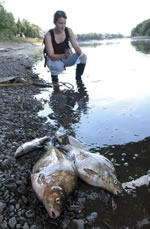The New Thames Tunnel – Blight or Blessing?
Thames Water’s Phil Stride provides project’s historic and technical background
Around 60 people crowded in to Chiswick Pier House on Tuesday 7th October to hear the latest on the new Thames Tunnel from lead engineer Phil Stride from Thames Water.
Phil provided historic and technical background to this massive engineering project, but many of the audience were most interested in hearing about the nature and likely location of the one of the tunnel's main shafts.
Phil told the audience that a decision on the selected site would not be made for around two years and only after wide public consultation. The first step was to agree a methodology for selection with local councils, then investigate a wide range of sites for suitability, whittling these down to a short list in around a year's time.
The works area would cover 2-3 football pitches. Spoil from the tunnel would be brought up the 25 metres wide shaft, and ideally removed by barges, which could also be used to bring in materials and equipment. Work was planned to start in 2012 and the tunnel should be in commission by summer 2020. If not, the Government could face heavy EU fines.
In order to comply with EU regulations on water quality, London must stop raw sewage spilling into the river at times of heavy rain. A tunnel under the river to catch this discharge was chosen as the best option to prevent the kind of fish deaths experienced in August 2004, when 10,000 fish and 100,000 fish fry perished. The tunnel should then enable us to rightly claim that the Thames is one of the cleanest city rivers in the world.
This event was the first of the Chiswick Pier's winter talks: the next on November 4th will see the famous Thornycroft Bell unveiled by the President of Thornycroft's, Mr Usher, with a talk on shipbuilding in Victorian Chiswick.
For full details on all events at Chiswick Pier, go to www.chiswickpier.org.uk
October 9, 2008
Related links
|
